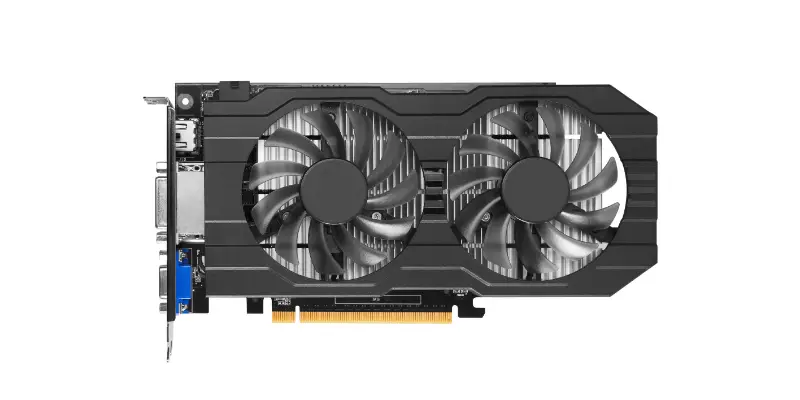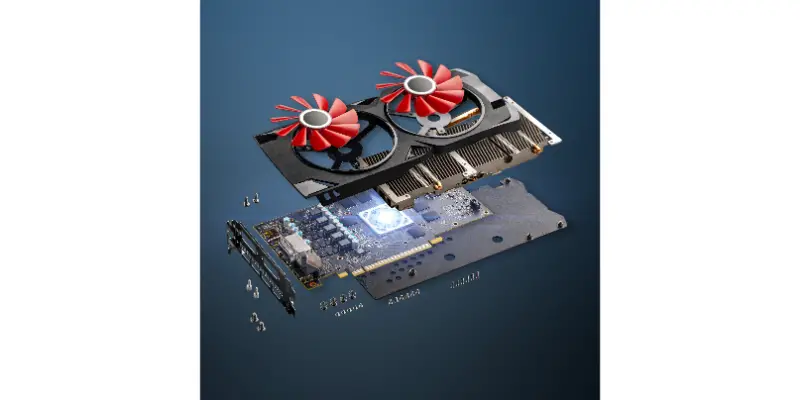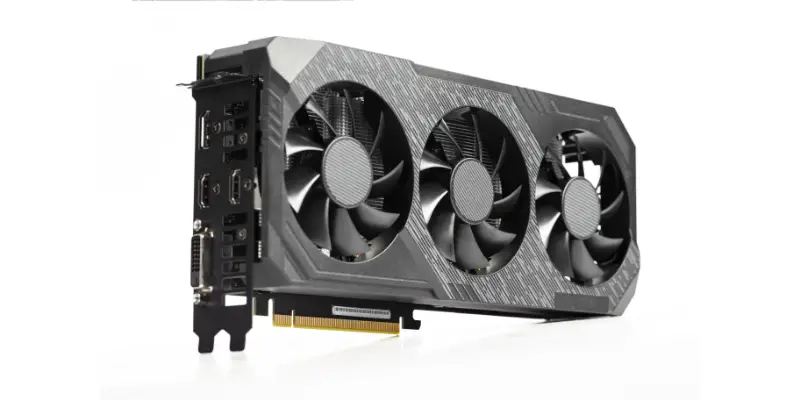Disclaimer: This post may contain affiliate links, meaning we get a small commission if you make a purchase through our links, at no cost to you. For more information, please visit our Disclaimer Page.
When we are building our gaming computers, one of the most important components we look at is the GPU or the graphics card. We all know how important the graphics card is for giving us the best experience with our games. But the problem here is that you might be using a graphics card that is more than the entire motherboard can handle. So, can any graphics card work with any motherboard?
Not all graphics cards are compatible with any motherboard because motherboards come in all sizes and formats that may not be compatible with larger and newer graphics cards. But the good news is that most of the modern GPUs today are made to be compatible with any motherboard.
Graphics cards are becoming more important in today’s modern computing world because of how plenty of games are so advanced that they require only the best from your computer.
That said, even though you may have invested in the best graphics card that your budget can buy, never forget about the importance of the motherboard and whether or not your graphics card is actually compatible with it.
Table of Contents
Can you use any graphics card with any motherboard?
Gaming is becoming one of the biggest things to do in the world today. That’s because it has become more than just a hobby but has already become a professional sport and as a way for different people around the world to make money just by simply playing games.
So, because of that, there is a need for people to make sure that they have the best computers that are built to handle the job of competitive and high-level gaming in terms of speed, performance, and graphics capabilities. This is where the graphics capabilities of PCs come in.
If you are not going for a PC that is specifically designed for gaming, they usually have what we call “integrated graphics”, which come in a chip that is connected or built into the computer’s motherboard or the processor or CPU. You will most likely see these chips in more affordable desktop computers and in common laptops.
However, because integrated graphics are no longer capable of handling most of the demands of modern games today even though some integrated graphics chips are good enough to help the computer play games, there is now a need for computers to have dedicated graphics cards that are made and designed to handle all the graphics needs of a computer without forcing the processor to handle more stress (which is what happens with integrated graphics).
So, this dedicated graphics card or GPU is supposed to be connected to the motherboard using an expansion slot.
Now, in this regard, we have to understand that, as important as graphics cards may be, you need to make sure that you can actually use the graphics card. The graphics card will be rendered useless if you buy one that you can’t even use for your PC no matter how expensive the GPU may be.
And because the graphics card is connected to the motherboard, you need to look at the motherboard first. So, with that said, are all graphics cards compatible with any motherboard?
Before we answer that question, let’s get to understand more about what the motherboard is. While we do know that components such as the CPU, RAM, and storage drive are some of the most important internal components that will allow a computer to work, we have to look at the part that basically allows all of those components to work with one another.
This is where the motherboard comes in, which basically houses all of the computer’s internal parts and allows them to communicate and transfer with and from one another.
So, in that regard, if you want to use a graphics card, understand that it is important for your graphics card to be compatible with the motherboard because of how the motherboard is what will allow the GPU to communicate with all the other parts of the computer. That’s why it is necessary for us to understand how important the motherboard is.
This means upgrading your PC isn’t as easy as buying the best GPU that your money can afford and then plugging it into your motherboard because you have to know whether or not it is even compatible with the motherboard.
With that said, what you should know is that not all graphics cards will work with any motherboard because there are several factors that you need to look at before you would even know if your motherboard can handle the GPU.
Such factors include the port that is used by your motherboard as well as the size of the graphics card with respect to the size of the motherboard.
How do you know what graphics card is compatible with your motherboard?
Now that you know that not all graphics cards actually work with any motherboard, you have to look at some of the factors that will allow you to tell whether or not your graphics card is compatible with the motherboard you have on your computer.
PCI Express slot
Most of the more modern motherboards that have been in the market for the last five or so years usually come with a few expansion slots. A lot of these motherboards will have what we call the PCI Express slot that should be made to be compatible with a graphics card. The good news is that most, if not all, motherboards have this PCI Express slot that is made for the graphics card. But we will see later why not all GPUs are still compatible with all motherboards.
So, the PCI Express slot that is compatible with a graphics card should be an x16 slot. However, you should know that this slot has three different versions that are backward compatible.
In a sense, even if you are using a PCI Express 3.0 graphics card, you should still expect it to be compatible with a PCI Express 2.0 x16 slot. But the problem here is that there will be bandwidth limitations if you are running a newer GPU on a motherboard with an older version of a PCI Express x16 slot.
The belief is that newer PCI Express x16 versions double the previous version’s performance but you shouldn’t have a lot of problems as long as the graphics card you are using is only one version higher than the one on your motherboard.
Today, version 4.0 is becoming quite popular especially with the release of the RTX 30 series from Nvidia. Still, most motherboards that run on PCI Express 3.0 can handle the performance of the newer and more advanced graphics cards today.
That said, when it comes to the motherboard and the slots that you use for your graphics card, it is best to make sure that your motherboard has a free slot that is compatible with a GPU regardless of what versions the motherboard and the GPU are carrying.
Length and size
As mentioned, most of the graphics cards and the motherboards we have today are built to be universally compatible in the sense that they all handle PCI Express slots. However, even though that may be true, there are still some factors to consider when we look at GPU and motherboard compatibility. And such factors are the reasons why we said that not all graphics cards will work with any motherboard.
In that regard, the length and size of the graphics card become a huge factor when it comes to determining whether or not a GPU is compatible with a motherboard.
Most of the more powerful graphics cards we have in today’s market have huge fans that are made to help keep the graphics card cool during intense gaming moments. And this is the exact reason why some of these cards are actually nearly double the size of some of the GPUs we have today.
Because of how big these fans are and how they need to be underneath the card when you construct your PC, you need to have an unused slot and backplate in your motherboard just under the PCI Express x16 slot for your GPU. You will also need to measure the backplate distance between any of the other components so that the components will not block the graphics card. Essentially, you would need about an inch and a half of length to your card so that it will actually fit.
If you don’t know how long your chosen graphics card is, it is best to go to the manufacturer’s website or online forums so that you will know its size. Confirming how big the GPU is will allow you to tell whether or not it will fit your motherboard.
Power requirements
Again, we have established that you need to have PCI Express x16 in your motherboard for most graphics cards to be compatible with the motherboard itself. Meanwhile, you also need to have extra room in your motherboard for larger graphics cards. So, if you have both of those two, that still isn’t a guarantee that your graphics card can work with your motherboard.
So, in that regard, another thing that you need to take note of if you want your graphics card and motherboard to work seamlessly is for you to make sure that your motherboard can provide the GPU with extra power. This is important for graphics cards that are larger because they naturally need more electricity to work properly.
Most power supplies should have PCI Express power connectors but they can end up tied out of the way if your motherboard isn’t connected with any graphics card. Most of these connectors are black and should have a PCI Express label. Even if your power supply doesn’t have those connectors, you can still buy adaptors that you can connect to the SATA connectors found in your power supply.
Depending on the graphics card you want to go with, you need to know if it requires a 6-pin or an 8-pin connector. There are even cases where a power connector isn’t even required. This is important because bigger GPUs will naturally need a bigger connector to provide them with more power from the power supply.
A good example of that is the RTX 3080, which will require an 8-pin connector due to how large and powerful this graphics card is. Meanwhile, on the flip side, the older and much less powerful GTX 1050 doesn’t even need a power connector at all. It simply depends on the graphics card but it mostly has to do with the size and power of the GPU itself.
So, if you have a newer graphics card, make sure that you have a good power supply that should be able to have an 8-pin connector. PSUs sold prior to 2015 usually don’t have 8-pin connectors, and this is where you will need to buy a new power supply that’s compatible with your graphics card of choice.
Meanwhile, if you have a graphics card that needs to be connected to two PCI Express power connectors, you need to make sure that the connectors are connected to their own 12v rail on the power supply and on the same chain because they actually need their own 12v supply.
Sometimes, it can be difficult for you to make sure that your graphics card is supplied with enough power but the usual rule to follow is that you should be providing more expensive graphics cards with at least 600W PSU. That said, make sure that you have enough headroom in your power supply because there will be some power supplies that are already providing the other components with 80% of the PSU’s top rating.
This makes it even more difficult for you to provide the GPU with the power it needs on a consistent basis, and you are bound to run into some issues with power if there isn’t enough headroom in the power supply for your graphics card. You’d want to supply a large GPU with about 40% of your power supply’s capacity.
Now, this is important because you will never know how much power the GPU will need when you are playing games. There are some casual games that won’t require a lot of power from your PSU but the best games that have top-of-the-line graphics demands will have to make your graphics card work harder, which naturally requires it to need more power.
So, because you need to make sure that your GPU will always have enough power, 40% should be a good number when it comes to the headroom it requires from the power supply.
Can you put a new graphics card on an old computer?
So, now that you know whether or not your graphics card should be compatible with your motherboard, you might be wondering if you can actually put a new graphics card in a computer that is perhaps at least five years old. That means that most of its components are already a bit dated. So, is it possible to put a new graphics card on an older computer?
Again, let us go back to the factors that we talked about previously in the sense that, as long as the older computer has a motherboard that can provide the graphics card with the said requirements, then there is no reason why the graphics card won’t work with the motherboard.
For example, if your motherboard has a PCI Express x16 slot regardless of what version it might be and that it can provide enough space for your graphics card, then there shouldn’t be a problem at all. Of course, it is also important to look at the power that the power supply can handle as most of the older PSUs probably don’t have 8-pin connectors that are compatible with the newer graphics cards we have in the market today.
But, as long as you have all of those covered, there is no reason why the graphics card won’t work on your older computer. Still, if all the other components are also old and outdated, then don’t expect your graphics card to have the killer performance you are expecting to have because all the other components might struggle to keep up with it.
As such, it still is better to upgrade all of the other components as well.
Can a dead graphics card kill a motherboard?
What if you have a damaged graphics card that doesn’t work anymore but is still connected to the motherboard? What happens to the motherboard? Will it actually damage your motherboard to the point of killing it?
There is no consensus on this question because it may depend on a case-to-case situation especially when it comes to the type of motherboard that you have. There will be instances where the dead GPU may end up damaging the PCI Express slot but not to the point that it will take the entire motherboard down with it.
But, then again, it still is on a case-to-case basis because you really can’t tell for certain how electrical components work. Maybe if the graphics card is too damaged and it ends up frying, it might also short out the entire motherboard. This is why there are is no consensus answer when it comes to this question as different motherboards may react differently to different graphics cards. However, we are of the opinion that graphics cards that require more power might be more dangerous to your motherboard if ever the GPU is dead or damaged.
How to choose a graphic card?
If you are looking for the right graphics card for your computer, here are some of the things you need to look out for:
Nvidia or AMD?
There are only two players you need to be concerned about when it comes to the graphics card industry: Nvidia or AMD. While most people are more likely to go with Nvidia, there are also reasons why AMD can be a good choice for you.
Nvidia is still the leader in the industry especially with its powerful RTX 30 line of GPUs. However, AMD is quickly catching up and is actually competitive enough with its RX 6000s cards. Moreover, if you are on a budget, AMD cards tend to be on a more affordable side as well.
How much are you willing to spend?
At the end of the day, it all boils down to how much you are willing to shell out because different graphics cards will have different prices depending on their performance.
For example, the high-end RTX 3090 cards will be at least $1,500, which should be more than enough at the middle portion of the pack.
Meanwhile, if you are not looking to prioritize overall performance and graphics capabilities because you don’t have the budget, you can still do well with graphics cards that are somewhere between $500 and $1,000. Just don’t expect them to handle ultra-high settings.
Which factors matter?
Here are the factors that matter when choosing a GPU:
- It is important to choose a graphics card that has enough memory because you don’t want the RAM to overload when you are handling high-end games.
- The form factor is also important because, as we stated, you need a graphics card that physically fits your motherboard.
- Power connectors are also vital because you need to make sure that you have a GPU that can be connected to your power supply.
- In terms of the overall speed and performance of the card, you need to look at factors such as clock speed, CUDA cores, and TFLOPS because knowing what these specs are will give you an approximate idea of how well the GPU will perform.
Conclusion
Choosing a graphics card shouldn’t only be about its specs and features because your computer is an entire unit that has different components that should be able to work well with another. After all, it doesn’t matter how powerful your GPU is if it doesn’t even fit the entire setup.
As such, it is important that you make sure that your GPU works well with your motherboard or is actually compatible with it in every sense so that you will be able to make the most out of what your graphics card has to offer. But, of course, if you do have an older motherboard, it doesn’t hurt to make an upgrade as well.




